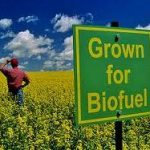Our view is that every energy source has its advantages and disadvantages – it’s unwise to promote or castigate hastily.
Below is a neat way of viewing the biofuels debate by a contributor to The Energy Collective. The agricultural sector is generally against the production of biofuels because it detracts from food production, and generally the Ag. sector resists change. Biofuels are politically attractive because they are a renewable and so a ‘green’ alternative, and because they are a ‘cleaner’ alternative to, say, burning coal. But is biofuel production, in the long term, a feasible alternative? Below you will read a clearly put view.
Biofuels and climate: a simple but troubling view
As a form of renewable energy, biofuels are promoted as a way to reduce excess emissions of carbon dioxide (CO2), the primary greenhouse gas (GHG) that is disrupting the earth’s climate. Ethanol and other forms of bio-based energy also find solid support as farm products and their firmest backing is found in states with strong agricultural interests. The desire to “rely on the Midwest, not the Mideast” makes boosting biofuels a patriotic quest. With environmentalists raising the green banner along side the red, white and blue of agribusiness and energy security, biofuels have enjoyed a political consensus as broad as ever seen on any issue in this day and age. When the Renewable Fuel Standard (RFS) was expanded to mandate 36 billion gallons of ethanol, biodiesel and other biomass-based fuels by 2022, the Senate vote was 86 to 6.
Nevertheless, the climate benefits of biofuels have been debated for many years. The discussions are often contentious, with warring studies that compare the carbon footprints of different fuels under competing assumptions. The passage of the RFS and its provisions for carbon footprinting (technically termed lifecycle analysis) and similar requirements in California’s Low Carbon Fuel Standard (LCFS) means that these long-running academic debates now take on high stakes commercially. Billions of dollars of investments have been made in new biorefineries, mainly for ethanol but also for biodiesel. Hundreds of millions of dollars of venture capital and taxpayer subsidy are being spent on the quest for next-generation biofuels in the hope that they can be made from non-food crops, tree plantations and forest trimmings, wastes, algae and even synthetic life forms being created in the lab.
The core of this debate and a basic tenet of the lifecycle view is the fact that the carbon in a biofuel was recently absorbed from the atmosphere and so exactly cancels out the CO2 released when the biofuel is burned. This “renewability shortcut” in carbon footprint calculations presumes that biofuels are inherently carbon neutral. As an accounting convention, it implies that if feedstocks are grown and converted into fuels efficiently enough, then replacing a fossil fuel with a renewable fuel such as ethanol from biomass cuts GHG emissions overall.
It’s the big “if” about the net GHG emissions of the biofuel production chain — from the need for land and nutrients to the emissions during processing, refining and distribution — that is so difficult to ascertain. In trying to patch over the carbon neutrality assumption, lifecycle analysis becomes inordinately complex and too unreliable to yield sound answers. A new paper concludes that evaluating biofuels through lifecycle analysis is a lost cause, overwhelmed by scientific uncertainties and undone by the intractable system boundaries involved when accounting for GHG impacts throughout the global and dynamic commodity markets that supply feedstocks and fuels. A legal critique of such flaws in carbon footprinting is one basis for the recent court decision blocking California’s LCFS.
There is an easier way to look at the issue and that is to focus not on the carbon neutrality of biomass, but rather on the fact that the CO2 released when burning a biofuel for energy is essentially the same as the CO2released when burning an equivalent amount of fossil fuel. This simple function of chemistry bears emphasis because we’ve become so accustomed to thinking that the carbon in biofuels doesn’t count. In round numbers, burning a gallon of gasoline directly releases 19 pounds of CO2 and so does burning an equivalent amount of ethanol. As a finer point of chemistry, the exact numbers differ by 0.4 percent and similarly, the CO2 directly released by biodiesel differs from that of petroleum diesel by roughly one percent.
In short, the benefit of biofuels is not in the burning. The atmosphere is better off only if the growth of biofuel feedstocks pulls more CO2 from the air than happens when growing plants for other reasons. This perspective implies that the focus should really be on maximizing CO2 uptake by the biosphere and, once the carbon is fixed, doing everything possible to keep it from being re-emitted.
Pulling CO2 from the air is not easy. Doing so with chemical engineering is very difficult. Photosynthesis evolved to fix carbon, but exploiting it productively is resource intensive, requiring lots of land, water and nutrients. That’s the perennial challenge of sustainable agriculture, and large-scale agriculture is, after all, itself a net emitter of greenhouse gases. In a climate-concerned world, fixed carbon should be treated as a precious substance. It’s awfully hard to re-absorb and also tricky to sequester once it’s been combusted into CO2.
If one sets aside the carbon neutrality presumption and realizes that the immediate atmospheric impact of a carbon-based fuel is the same regardless of its origin, the following question comes to mind. Once CO2 has been fixed through carbon uptake, does it make sense to expend more energy and release more emissions to process it into biofuels, only to burn that hard-gained carbon and re-release it to the air?
The answer will rarely be yes. That is a conclusion in line with the acknowledged value of reducing deforestation and seeking ways to rebuild terrestrial carbon stocks through forest regrowth and other natural area restorations that accumulate carbon. Given that bio- and fossil fuels emit the same CO2 when burned, one can more confidently counterbalance emissions with carbon offsets than with the huge uncertainties involved in modeling the carbon footprints of biofuels. Offset programs pay great attention to issues of verification, additionality, leakage and permanence. These challenges are best addressed by policies that focus on the locations where sequestration is enhanced or is at risk. It is futile to try to address them through complex lifecycle and econometric modeling of biofuels used far from the locations where CO2 uptake, sequestration and land-use activities occur.
A troubling implication is the need to reconsider efforts to synthesize biofuels from various forms of biomass. Rather than continuing the decades-long struggle to break down the cellulose and lignin that comprise the bulk of plants, or to bioengineer plants, algae or other life forms to increase their production of molecules amenable for making transportation fuels, it makes more sense to search for ways to keep carbon from turning into CO2while finding other uses for the biomass.
With agricultural and forestry wastes, for example, instead of pursuing the still largely quixotic quest to turn them into fuel, it may be better to develop chemical processes that maximize the fixed carbon residue while exploiting as much hydrogen as possible for energy. Carbon in a solid form or enriched in nonvolatile compounds is easier to dispose of than CO2. It might also be valuable as a construction material or basis for other long-lived products that keep the carbon out of the air. This means foregoing the copious combustion energy of carbon, so there’s an opportunity cost, but it may well be a more cost-effective way to limit emissions than all the processing involved in turning biomass into a convenient fuel that gets burned and releases CO2anyway.
This simplified view of biomass and energy raises a lot of questions and provokes new research needs. It could spell an end to years of conventional but irresolvable thinking about biofuels, which as far as climate protection is concerned, may turn out to be but a long road to a dead end.
John M. DeCicco holds a joint appointment as Research Professor at the University of Michigan Energy Institute and Professor of Practice at the School of Natural Resources and Environment. A nationally recognized expert on transportation energy use, his work focuses on analysis of vehicle-fuel systems, petroleum demand, greenhouse gas (GHG) emissions and the broader socioeconomic impacts of transportation. He also teaches and guides student research on these topics and general issues of sustainable energy systems, global climate mitigation and environmental policy. Previously Prof. DeCicco was Senior Fellow for Automotive Strategies at the Environmental Defense Fund (EDF, 2001-2009) and Transportation Director at the American Council for an Energy-Efficient Economy (ACEEE, 1990-2000). He has testified before Congress and other federal and state policy bodies, was appointed to a presidential advisory committee (“Car Talk,” 1994-95) on reducing GHG emissions from personal vehicles, and has served on numerous other committees and panels, including as Chair of Transportation Research Board (TRB) Energy Committee (1996-2000). His studies of vehicle efficiency have been influential in the development of regulatory, incentive and information programs to address automobile energy use and GHG emissions. His current research explores the complexities of vehicle-fuel systems, opportunities for addressing GHG emissions from fuels, and the synergies between intelligent vehicle systems and transportation energy use. Prof. DeCicco has three books and over 100 published papers, reports, formal public comments and testimonies to his credit. He is also a leader in consumer information about cars and the environment, pioneering green car ratings in the United States as the author of ACEEE’s Green Book (launched in 1998) and most recently with a new venture,www.AutoEcoRating.com. He holds a B.A. in mathematics from Catholic University of America, an M.S. in Mechanical Engineering from North Carolina State University and a Ph.D. in Mechanical Engineering from Princeton University (1988).





